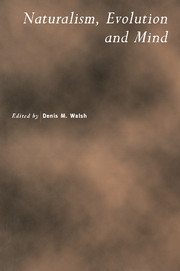Book contents
- Frontmatter
- Contents
- preface
- Notes on Contributors
- Editor's Introduction
- Mind the Adaptation
- Should Intentionality be Naturalized?
- Norms, History and the Mental
- What has Natural Information to do with Intentional Representation?
- Locke-ing onto Content
- The Evolution of Means-End Reasoning
- Rationality and Higher-Order Intentionality
- Theory of Mind in Non-Verbal Apes: conceptual issues and the critical experiments
- The Principle of Conservatism in Cognitive Ethology
- Domains, Brains and Evolution
- Evolution and the Human Mind: how far can we go?
- Index
Should Intentionality be Naturalized?
Published online by Cambridge University Press: 10 May 2010
- Frontmatter
- Contents
- preface
- Notes on Contributors
- Editor's Introduction
- Mind the Adaptation
- Should Intentionality be Naturalized?
- Norms, History and the Mental
- What has Natural Information to do with Intentional Representation?
- Locke-ing onto Content
- The Evolution of Means-End Reasoning
- Rationality and Higher-Order Intentionality
- Theory of Mind in Non-Verbal Apes: conceptual issues and the critical experiments
- The Principle of Conservatism in Cognitive Ethology
- Domains, Brains and Evolution
- Evolution and the Human Mind: how far can we go?
- Index
Summary
One goal of recent philosophy of mind has been to ‘naturalize’ intentionality by showing how a purely physical system could have states that represent or are about items (objects, properties, facts) in the world. The project is reductionist in spirit, the aim being to explain intentional relations—to say what they really are—and to do so in terms that do not themselves utilize intentional or semantic concepts. In this vein there are attempts to explain intentional relations in terms of causal relations, informational relations, teleological or functional relations, relations involving abstract similarity or isomorphism, and various combinations thereof.2 What makes these accounts naturalistic is the presumed objectivity and scientific respectability of the properties appealed to in the explanans. What makes them all reductive is their shared presumption that intentionality can be explained in terms that have a wider application to intentional systems as well as to systems that have no mental properties at all.
I emphasize the reductionism implicit in the naturalizing project because it the source of an ongoing debate amongst naturalist sympathizers. Some, like Fodor, see a successful reduction of intentional relations as necessary for a naturalistic world-view. As he puts it:
The worry about representation is above all that the semantic (and/or intentional) will prove permanently recalcitrant to integration in the natural order.… What is required to relieve this worry is therefore, at a minimum, the framing of naturalistic conditions for representation … of the form ‘R represents S’ is true iff C.… (Fodor, 1984, p. 32).
- Type
- Chapter
- Information
- Naturalism, Evolution and Mind , pp. 43 - 86Publisher: Cambridge University PressPrint publication year: 2001

